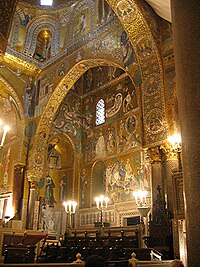
Back Capella Palatina de Palerm Catalan Cappella Palatina German Παλατινό Παρεκκλήσιο (Παλέρμο) Greek Palaca Kapelo de Palermo Esperanto Capilla palatina de Palermo Spanish Kapera Palatinoa (Palermo) Basque کلیسای پالاتینا Persian Chapelle palatine de Palerme French קפלה פלאטינה HE Palatinus-kápolna (Palermo) Hungarian

The Palatine Chapel (Italian: Cappella Palatina) is the royal chapel of the Norman Palace in Palermo, Sicily. This building is a mixture of Byzantine, Norman and Fatimid architectural styles, showing the tricultural state of Sicily during the 12th century after Roger I and Robert Guiscard conquered the island.
Also referred to as a Palace church or Palace chapel,[1] it was commissioned by Roger II of Sicily in 1132 to be built upon an older chapel (now the crypt) constructed around 1080. It took eight years to build, receiving a royal charter the same year, with the mosaics being only partially finished by 1143.[1] The sanctuary, dedicated to Saint Peter, is reminiscent of a domed basilica. It has three apses, as is usual in Byzantine architecture, with six pointed arches (three on each side of the central nave) resting on recycled classical columns. The muqarnas ceiling of the nave and the chapel's rectilinear form show the Fatimid influence in the building's construction.
- ^ a b Ćurčić 1987, p. 125.